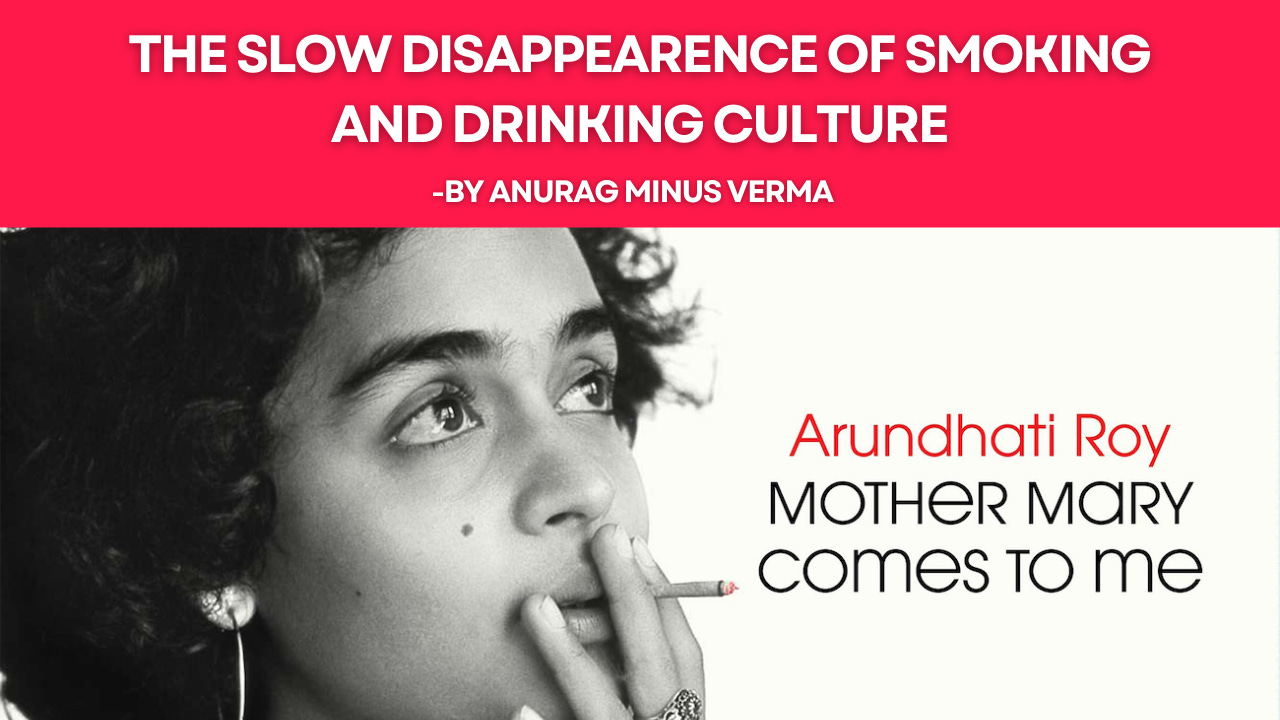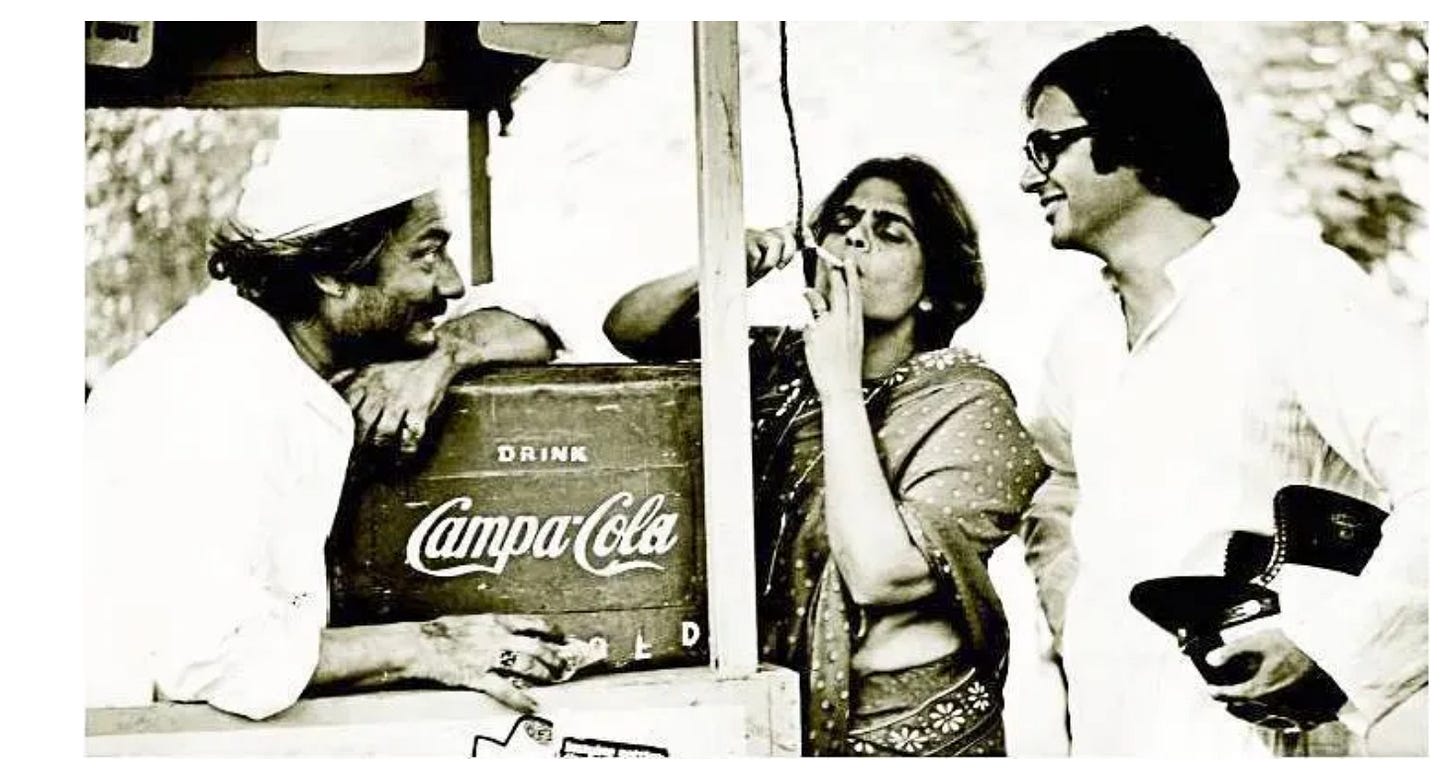The Slow Disappearance of Smoking and Drinking Culture
On the fading cool of cigarettes, the decline of hangovers, and the rise of stranger pleasures
A few weeks ago, when I saw Arundhati Roy’s new book cover with what some claimed was a bidi and others, in their non-stoner wisdom, suggested was a joint, it took me back to film school. I had no idea then whether it was a cigarette or a bidi, but the cover reminded me of an old truth that smoking back then was related to certain aura. A cigarette in hand was a badge of rebellion, a small performance that you were an artist. The most celebrated image was Muktibodh, a poet few had read but everyone admired because he looked like a man who didn’t give a F.
Smoking was the costume of youth. It was freedom, defiance, and cosmic rhythm rolled into paper. And that song, har fikr ko dhuein mein udata chala gaya, declared that all it really took was a drag of nicotine to be airlifted from the land of misery.
In the Indian sense, there was also something modern about smoking. Especially the image of a woman smoking, which was and still is judged, and for that reason once appeared jarring. Back then even smokers judged women who went to a paan shop to buy cigarettes, branding them as having loose character, all while they themselves were lost in a nicotine high. I remember the famous photograph of Chashme Buddoor’s director Sai Paranjpye smoking during the shoot. Many on internet, based on this photo, commented that Sai was the coolest filmmaker. Having met Sai, I can say she is indeed cool, though not because of the cigarette. (Will write about my experience of meeting her in detail but you can watch podcast here)
When I went to the US, I was told about the history of smoking there. Tobacco companies once sent people into African American neighborhoods to distribute free cigarettes. In the 1950s, Liggett & Myers ran campaigns for their Chesterfield brand, giving away free packs at film screenings in African-American colleges. By the 1960s, Philip Morris was handing out free cigarettes at events honoring Black newspaper founders. Over the years, companies relied on menthol brands, ads, and giveaways to turn Black neighborhoods into steady markets. A similar story exists in India about how chai became popular. I watched a video by Krish Ashok few days back where he explained how in colonial era, marketing men went to villages and towns handing out free samples of tea. Once people got addicted, a new market opened up for the business of chai.
But today, cigarettes and alcohol, while still romanticised by some, are steadily losing their grip on popular culture. The evidence is everywhere, pointing to a slow retreat of the old glamour. In that sense, the cover of Roy’s book felt a little dated to me. But then a friend reminded me on Instagram that Arundhati Roy had been trolled by a few celebrated Hindi authors on Facebook. These men, embodiments of the old guard and their Brahmanical notions of purity, were outraged by the image and declared it outside the limits of maryada. That is when I realised I had misjudged the idea of progress. In India, we live with so many taboos that you can never be certain when you have broken one. Even the most ordinary act of pleasure might inadvertently break a taboo. Perhaps it should be notified to us like traffic challans that suddenly appear on an app. You never know when you committed the violation, but the authorities always know.
But my point is not to dwell on the comments of old patriarchs (which Hindi literature is a bastion of) or the morality attached to smoking. My interest lies in understanding culture and how it is shifting at a global level. It is now widely debated that this generation drinks and smokes less compared to the ones before. The current mood suggests that alcohol and cigarettes are no longer seen as their primary sources of pleasure.
I came across a video about how many clubs in Berlin are shutting down, and people are puzzled. This is unusual because Berlin is a city built on clubs, where the party culture is central to its identity. The video explained that Gen Z is simply not drinking the way earlier generations did. Instead, they are inventing odd new rituals on TikTok. One of them is called the “fridge cigarette,” which has nothing to do with smoking. It is the act of reaching into the refrigerator, pulling out a cold Diet Coke, and treating it as a calming ritual after a long day. Clips with lines like “Time for my afternoon fridge cigarette” or “Just a little something to take the edge off” have become viral on social media
In popular culture sobriety is becoming cool and people are shifting toward health trends. American podcasts have done lot of the heavy lifting. Andrew Huberman has whole episodes devoted to what alcohol and nicotine do to the brain. Some other voices like Lex Fridman and Joe Rogan also regularly surface the ill effects of drinking and smoking. The idea now is that smoking is as uncool as “chaini khani” used to be. The old test of manhood, how many shots you could take or how many cigarettes you could chain-smoke, feels more and more stupid.
Drinking was also a kind of barter system: one great night in exchange for a terrible morning. If you are a believer then you might believe that perhaps hangovers are God’s sermon preaching long term happiness does not lie at the glass of beer.
There is actual data to back this up. The “sober curious” movement, where people want to rethink their relationship with alcohol without necessarily quitting entirely, is growing fast. In the United States surveys show that a majority of Gen Z plan to drink less this year, many considering a “dry lifestyle” for longer stretches. In Europe, for example, beer consumption among younger people is in decline, and alcohol free bars and sober parties are becoming more common.
But what is interesting is what has replaced them in popular culture. Drugs like mushrooms, MDMA etc are very popular. Vaping has become the new cool instead of smoking. Smoking a joint is now just another addition to the habit list. Unlike drinking, where the very next day your body screams at you, weed does not come with such alarms. The body stays quiet, which is worse, because it can give you the delusion that it is helping you achieve your goals and making you more productive.
There are also the beginnings of coffee raves, one of the trends I dislike the most, where people gather in coffee shops to pretend they are enjoying themselves while a DJ plays techno and house. Coffee shops, once shelters for those who wanted to hide from the world, are now infiltrated by this contrived performance. The sheer ridiculousness of it suggests it may vanish as quickly as dalgona coffee.
Then there are cocktail trends, which are not about getting drunk but about drinking with elegance. Each drink comes with a story so that it gives you an illusion that you are consuming a painting in an art gallery rather than toxic alcohol. I was once in Rajasthan where a bartender, assuming I was an outsider, gave me a cocktail and proudly explained, “Sir, we are using ker in this drink for the sour agent instead of lemon. Ker is a desert fruit, and this drink is our homage to the folk tradition of vast desert of Jaisalmer.” I was tempted to tell him he should also mix some sand in it.
These are some of the new trends, but culture is cyclic and one can never be too sure of what is in and what is out. When I posted the story on Instagram, a professor wrote to me saying that the same old pattern is back, and many of his students are smoking like chimneys. I am not sure if this is just an anecdotal experience or if the wheel has truly turned again. That is the thing with habits, they rarely die, they only hide for a while and wait for their comeback. For every wellness rave or kombucha bar, there will always be a hostel room where a group of students believe they have discovered freedom in smoke. Perhaps Gen Z is not abandoning these pleasures entirely, only remixing them in new forms. I would love to hear from you, especially from Gen Z, on what you make of all this.
Also, a full conversation on this topic is now streaming on YouTube. I have started a new section called In the Mood for Diss-Course where we discuss cultural absurdities. In this episode, we talk in detail about alcohol, creativity, writing, and much more. Here is the link to the podcast. Please do watch it.





In the past, there was a Promise. Nothing specific or concrete, but an unspoken assumed promise of something more to life, something better. One stepped out of the mundane and the madness by smoking a cigarette or having a drink to connect quietly to that Promise.
That Promise seems to have disappeared. It has been erased from our lives, just as Nietzsche’s madman with the lantern accused the villagers of wiping away the horizon with a sponge. It is not that cigarettes or alcohol are no longer cool. It is that there is nowhere to escape to.
You won't believe: so I got my copy of the book, and with it came a tote with the cover on it. I took that out in the metro in Bangalore, and a woman chastised me for it! Haha I love the constant identity crisis that is this luru <3